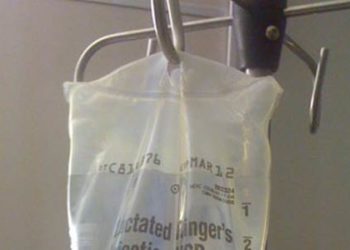The Rivers trial: Early goal-directed therapy in severe sepsis and septic shock [Classics Series]
1. Early goal-directed therapy in patients with severe sepsis and septic shock prior to admission to the intensive care unit significantly reduced organ dysfunction and mortality rates compared to standard therapy to achieve parameters for hemodynamic support.
Original Date of Publication: November 8, 2001
Study Rundown: The systemic inflammatory response syndrome (SIRS) can be diagnosed when two of the following criteria are present: 1) body temperature <36oC or >38oC, 2) heart rate >90 beats/min, 3) respiratory rate >20 breaths/min. or PaCO2 <32 mmHg, or 4) WBC <4×109/L, WBC >12×109/L, or >10% bands. Sepsis refers to SIRS that results from infection and this can progress to severe sepsis (i.e., sepsis with organ dysfunction, hypoperfusion, or hypotension) or even septic shock (i.e., severe sepsis with hypotension despite adequate fluid resuscitation). In this spectrum of conditions, circulatory changes may arise, resulting in insufficient oxygen delivery to meet metabolic demands. These changes lead to global tissue hypoxia, which may foreshadow multiorgan failure and death. The onset of global tissue hypoxia represents a key point in the development of sepsis, where intervention may help to avoid poor outcomes.
Commonly referred to as the Rivers trial, this study sought to explore whether early goal-directed therapy (EGDT) before admission to the intensive care unit (ICU) significantly reduced the incidence of multiorgan dysfunction, mortality, and the use of health care resources compared to standard therapy in patients with severe sepsis and septic shock. In summary, patients in the standard therapy group had significantly higher APACHE II, SAPS II, and MODS compared to patients receiving EGDT (p<0.001 for all comparisons), thereby suggesting worse organ dysfunction in the standard therapy group. Moreover, the EGDT group experienced significantly lower in-hospital (RR 0.58; 95%CI 0.38-0.87), 28-day (RR 0.58; 95%CI 0.39-0.87), and 60-day mortality rates (RR 0.67; 95%CI 0.46-0.96) when compared to patients undergoing standard therapy.
Click to read the study in NEJM
In-Depth [randomized, controlled study]: This study, conducted at one tertiary centre in Detroit, randomized 263 patients to either standard therapy or EGDT for 6 hours prior to ICU admission. Patients were included in the trial if they met SIRS criteria and a systolic blood pressure ≤90 mmHg or a serum lactate ≥4 mmol/L. Exclusion criteria included age <18 years, pregnancy, or the presence of an acute cerebral vascular event, acute coronary syndrome, acute pulmonary edema, status asthmaticus, cardiac dysrhythmias, contraindication to central venous catheterization, and burn injury, amongst others. Outcome measures were vital signs, resuscitation endpoints, measures of organ dysfunction (i.e., APACHE II, SAPS II, MODS), and mortality. In the EGDT group, all patients received arterial lines and central venous lines with the ability to monitor central venous oxygen saturation (ScvO2). EGDT involved targeting a series of treatment goals for patients:
- Central venous pressure (CVP) ≥8-12 mmHg (through crystalloid boluses)
- Mean arterial pressure (MAP) ≥65 mmHg (through vasopressor administration)
- Urine output ≥0.5 mL/kg/hour
- ScvO2 ≥70% (through transfusion of red cells and dobutamine)
After the initial 6-hour period, patients receiving standard therapy had significantly higher APACHE II, SAPS II, and MODS compared to those receiving EGDT (p<0.001 for all comparisons), thereby suggesting higher levels of organ dysfunction in the standard therapy group. Moreover, in-hospital mortality rates (RR 0.58; 95%CI 0.38-0.87), 28-day mortality (RR 0.58; 95%CI 0.39-0.87), and 60-day mortality (RR 0.67; 95%CI 0.46-0.96) were all significantly lower in the EGDT group. There were no significant differences between the two groups in terms of measures of health care resource consumption (i.e., mean duration of vasopressor therapy, mechanical ventilation, hospital stay).
Image: PD
©2012-2014 2minutemedicine.com. All rights reserved. No works may be reproduced without expressed written consent from 2minutemedicine.com. Disclaimer: We present factual information directly from peer reviewed medical journals. No post should be construed as medical advice and is not intended as such by the authors, editors, staff or by 2minutemedicine.com. PLEASE SEE A HEALTHCARE PROVIDER IN YOUR AREA IF YOU SEEK MEDICAL ADVICE OF ANY SORT.





